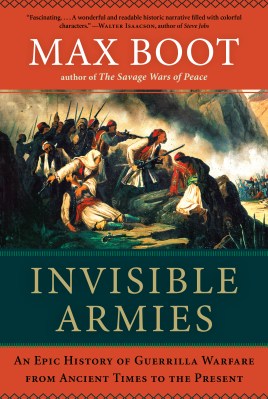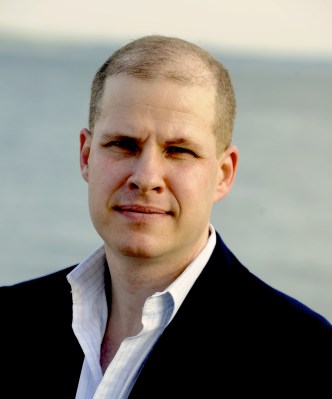Theodoros Vryzakis’ “The destruction of Dramali at Dervenakia,” from the National Gallery in Athens, in reverse
Hawkish historian Max Boot is out with a book on insurgency. In Invisible Armies: An Epic History of Guerrilla Warfare from Ancient Times to the Present, the emphasis is on the epic – the tome weighs in at 750 pages. It’ll be released Tuesday, Jan. 15.
Seeing as the campaigns in both Afghanistan and Iraq have been more irregular than regular, perhaps it’s an apt time for a primer on the topic. And who’s a better guide than Boot, author of 2002’s The Savage Wars of Peace: Small Wars and the Rise of American Power, and 2006’s War Made New: Technology, Warfare, and the Course of History, 1500 to Today. Battleland conducted this email chat with Boot, who hangs his helmet at the Council on Foreign Relations, last week:
What is the bottom line of Invisible Armies: An Epic History of Guerrilla Warfare from Ancient Times to the Present?
I wrote Invisible Armies not to make a particular point but simply to tell a story that has never been well told before—the story of guerrilla warfare and terrorism as it has developed over the last 5,000 years, from the days of ancient Mesopotamia to modern Iraq and Afghanistan and beyond.
I was particularly enthralled with so many great characters—such as Giuseppe Garibaldi, Edward Lansdale, Gerald Templer, Hubert Lyautey, to name just four—who are not well known to the public. I tried to bring them alive for the reader. There is no agenda, political or otherwise, in this book.
That said, there are a number of lessons one can draw from this history and at the end of my narrative I draw out a dozen “implications.” The first and most important lesson is that guerrilla warfare has been ubiquitous throughout history.
It always has been and always will be the dominant form of warfare.
Those who imagine that it is a passing fad—one that will go away with the American withdrawal from Afghanistan—are dreaming. If we are not prepared to counter insurgencies in the future, we will pay a high price, as we have already done in Vietnam, Iraq, Somalia, and other battlefields.
Define guerrilla warfare? Has that definition changed over the eons?
“Guerrilla” literally means “small war.” The term gained currency during the Spanish resistance to French occupation from 1808 to 1814. But the practice it describes is as ancient as it is hard to define.
For purposes of my book I wrote that guerrilla warfare describes “the use of hit-and-run tactics by an armed group directed primarily against a government and its security forces for political or religious reasons.” At the tactical level, guerrilla warfare is often indistinguishable from light infantry warfare waged by conventional forces. The difference is, as I wrote, that “guerrilla warfare lacks front lines and large-scale, set-piece battles.”
Distinguishing guerrillas from terrorists is trickier; I argue that terrorists place more focus on attacking non-combatants, their groups are usually smaller, and they do not try to hold territory. Essentially I posit there is a continuum of conflict with terrorists at the bottom, guerrillas in the middle, then conventional forces, and finally weapons of mass destruction. I’m sure other experts could nitpick my definitions; there is no universally-agreed upon definition.
Are guerrilla wars tougher to win than conventional wars? Why or why not?
In many ways, yes, they are tougher.
For a start they tend to last longer. According to a database of insurgencies that I compiled for this book, the average insurgency since 1945 has lasted 9.7 years (before 1945 it was 5.5 years).
The annals of conventional conflicts are full of lightning successes such as the German blitzkrieg through Western Europe or the Israeli victory in the Six Day War. Guerrilla conflicts, by contrast, tend to be a long, slow slog. This is primarily, of course, because of the difficulty of identifying your foes.
That’s why I call the book Invisible Armies—if guerrillas came out in the open they could be swiftly annihilated. But because they hide, either by donning civilian clothes or by taking refuge in remote locales, or often both, they can be very hard to uproot.
Were either the Afghanistan or Iraq conflicts – or any part of them – guerrilla wars?
Both wars were primarily guerrilla conflicts. This is obscured by the fact that we tend to label all of our enemies as “terrorists” (or “dead-enders”), because this is seen as a derogatory term, rather than calling them “guerrillas,” which sounds more laudatory.
Many other counterinsurgents have engaged in the same rhetorical sleight-of-hand; the British liked to label insurgents during the Malayan Emergency in the 1950s as “Communist-Terrorists.”
There is no doubt that there has been a lot of terrorism in both Iraq and Afghanistan, but it was primarily directed not at our forces but at civilians. For instance, the suicide bombers driving trucks full of explosives into crowds of Iraqi Shiites. Most of the attacks on our forces, carried out with IEDs, have been classic guerrilla hit-and-run raids.
Mao said “the guerrilla must move amongst the people as a fish swims in the sea.” Was he right? If so, what does that fact portend?
Mao was absolutely right, at least in the modern context.
Historically many guerrillas were nomadic warriors—e.g., the Huns or Xiongnu—and they did not depend on popular support among the populations they targeted. They simply killed anyone who got in the way, and many who did not. But there are few nomads left anymore.
In the past couple of centuries, insurgency has become intensely political. Both insurgents and counterinsurgents are trying to control the population through a combination of measures. Providing security for the people—i.e. positioning men with guns among them on a sustained basis to deny the enemy the opportunity to collect money or intelligence–is the first and most important operation for either side.
Second-most important is having legitimacy for your actions which often comes from promising political or social benefits to the people. Both insurgents and counterinsurgents can go astray if they are distracted from these essentials.
Consider Iraq. Abu Musab al-Zarqawi, the founder of Al Qaeda in Iraq, lost sight of the need for popular legitimacy; by slaughtering Shiites indiscriminately and oppressing his fellow Sunnis he sparked a backlash—even Ayman al-Zawahiri, now the leader of Al Qaeda, criticized him.
On the other side, U.S. forces prior to 2007 were more focused on chasing insurgents than on controlling the population, which is why they did not have more success until they switched strategies during the “surge.”
Why does someone become a guerrilla fighter?
Guerrilla warfare is the war of the weak.
Few if any insurgents have ever chosen this form of warfare voluntarily, because it entails considerable hardships and has few prospects of immediate reward. Most terrorist groups have struggled to become guerrillas and most guerrillas have struggled to become conventional armies.
Guerrillas are generally similar in their psychological makeup to regular soldiers. Many terrorists, on the other hand, have been intellectuals, loners, or even psychopaths: terrorism is a much lonelier, more extreme business than waging guerrilla warfare, and therefore tends to draw more extreme personality types.
But both guerrillas and terrorists tend to be motivated by a desire for revenge for perceived wrongs to them, their families, and whatever group or class they identify with. Typically they take a violent route for a redress of grievances because peaceful avenues to attain their objectives are not available.
What guerrilla movement was the most militarily successful? The least?
Many guerrilla movements have been phenomenally successful. Think just of the Chinese and Vietnamese Communists whose leaders—Mao Zedong and Ho Chi Minh—became legends in the annals of guerrilla warfare.
Many other guerrillas, on the other hand, have failed to achieve their objectives. From Shamil’s fight against Russian forces in Chechnya and Dagestan in the mid-19th century, to the fight of his descendants for independence from Russia in more recent years, the annals of insurgency are littered with failed uprisings.
Indeed, there have been more losing guerrilla movements than successful ones. Just as business startups don’t typically become Apple or Microsoft, so most insurgent groups don’t become the Viet Cong or the Chinese Red Army.
Is it right to think of guerrilla fighters as poorly-armed peasants, rising up against an oppressive ruling elite?
Historically this is accurate because throughout history most people in settled societies have been farmers (aka “peasants”), and thus they have formed the backbone of both armies and their insurgent adversaries. Since farmers generally prefer to till their fields, they take up arms as guerrillas only if they are conscripted or feel oppressed in some way.
A major exception can be found among the nomadic horse archers that terrorized the European steppe for millennia—the Xiongnu, Avars, Bulgars, Magyars, Huns, Mongols, and others. (The Sioux, Apaches, and other American Indian tribes were similar.) They were not peasants and they did not fight because they were oppressed. They fought because that is what men did in those warrior societies. Warfare was not an ideological cause but a way of life.
Traces of this outlook can still be found among the Pashtuns and other militaristic tribes around the world.
Do different motives make for better guerrillas? Is someone whose guerrilla fighting is fueled by religion more or less effective than someone fighting for economic freedom? Or is each guerrilla outfit sui generis?
There is a tendency to think that guerrillas motivated by religion are more formidable than those motivated by political motives—they are supposedly more willing to lay down their lives and less restricted by inhibitions about killing infidels.
It is true that suicide bombing is characteristic of Muslim extremists. Although a few non-Muslim groups (notably the Tamil Tigers) have carried out a few suicide operations, the modern phenomenon of suicide bombing was started by Lebanese Shiites in the early 1980s and exported to other Muslim lands; Iraq saw the worst carnage ever as a result of suicide attacks.
This makes groups such as Hezbollah and Al Qaeda in Iraq more ferocious than more secular guerrilla groups, but not necessarily more effective. Hezbollah actually gained its greatest power after abandoning suicide bombings (and hostage taking, another early tactic) in the 1990s. Al Qaeda in Iraq was so vicious that its tactics actually backfired and mobilized even Sunnis against it.
So far, few if any jihadist groups have had the success of secular insurgents such as the Chinese or Vietnamese Communists, who were also willing to die for their cause but did not make a fetish of suicidal attacks on civilians.
Will guerrilla warfare ever end? Why or why not?
At the end of my book I paraphrase Santayana: only the dead are safe; only the dead have seen the end of guerrilla war.
As long as there continue to be disaffected groups in the world there will continue to be guerrilla warfare and terrorism.




